Hello, welcome to the official website of Yunnan Shangri-La Balagezong Tourism Development Co., Ltd!

02
2015
-
12
The Origin and Significance of Tibetan Guozhuang Dance
作者:
Guozhuang dance, also known as "Guozhuo", "Gezhuang", "Zhuo", etc., which means circle song and dance in Tibetan language, is one of the three major Tibetan folk dances. It is distributed in Qamdo and Nagqu in Tibet, Aba and Ganzi in Sichuan, Diqing in Yunnan and Tibetan settlements in Qinghai and Gansu.
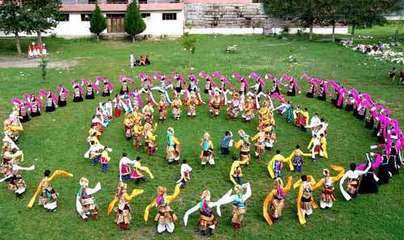
"As many stars as there are in the sky, Zhuo will have as many tunes; as many trees as there are in the mountains, Zhuo will have as many words. As many hairs as there are on yaks, Zhuo will have as many dancing postures". This is the praise of the rich Guozhuang dance. Guozhuang dance is actually a kind of happy dance, so whenever happy in the festive season, people regardless of young and old to dance. Such as moving to a new house, getting married and having a wedding, Spring Festival and Duanyang Festival, men, women and children all have to jump all night.
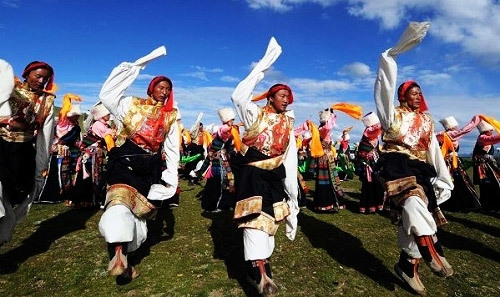
1. Historical Traceability
The term "Guozhuang" has a long history and is a common name for "Zhuo Wu. "Zhuo" is the transliteration of Tibetan. According to the lyrics and folklore of Guozhuang in Changdu County, Zhuo Dance, an ancient folk dance form, existed as early as the Tubo period. The early Zhuo dance was related to the Tibetan slave society and covenant activities, and then gradually evolved into a combination of singing and dancing, singing and dancing in the form of a circle. "Qing history draft · music" transliterated as "Guo Zhuang", modern times known as "song Zhuang". Zhao erfeng and others wrote "please history draft" volume 111, zhi 76 music eight records "Gao zong pacified Jinchuan, won the music day big pot Zhuang si dance ten people, every two people dance together, a dress python robe, Dai ling, hanging beads, diagonal yellow and blue two belts, cross. "This description of the Tibetan Guozhuang was still found in the temple Guozhuang in Qamdo in the early days of liberation. "Wei Zang Tongzhi" believes that "Guozhuang" means dancing around the stone pile of a pot. "Introduction to Tibetan Dance" records that in the former Kangding area, there was a commercial organization called "Guozhuang", which purchased local products, transshipped them on behalf of others, and set up inns in which Tibetan merchants who passed along the way often lived with caravans. In the evening, they often set up stone pots in the open space of the courtyard, cook tea and catch Zanba. After tea, they sing and dance around the fire pond from time to time to drive away the tiredness and fatigue of the day, maintain vigorous energy and adapt to the harsh environment.
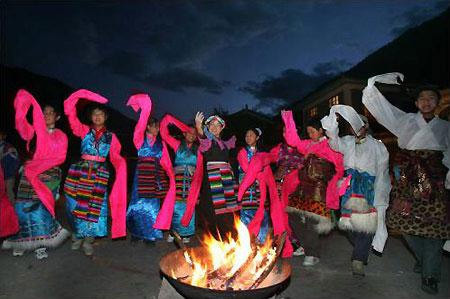
2. artistic features
Guozhuang dance is a kind of unaccompanied group dance. Guozhuang dance has many dance names, that is, the song card and the word card, nagging half-step dance, six-step dance, eight-step dance, suo example duo, monkey dance, peacock dance shepherd song and so on. The dance steps of Guozhuang dance are divided into two categories: "Guo Zhuo" (walking dance) and "dry dance" (turning dance). Dancing and singing at the side of the pot, mostly for quiz and duet competitions.
During the dance, men and women usually hold hands in a circle in each row, with one person leading the way. The men and women ask and answer questions and sing repeatedly without musical accompaniment. The whole dance consists of two dances: slow first and fast later. The basic movements include "leisurely trembling and crossing legs", "trending and turning", "stepping and squatting across legs", etc. The dancer's arms mainly change their dancing posture by lifting, swinging and shaking. The formation moves clockwise. The circle is large and small, and occasionally the pattern of "dragon swinging tail" is changed.
1. Artistic characteristics
Guozhuang dance is a kind of unaccompanied group dance. In Tibetan areas, some places call Guozhuang "Zhuo" (I. e. dance) and some places call it "rubbing" (I. e. play). It has a long history, dating back to before the seventh century. It has changed with the development and changes of Tibetan production and life. Therefore, the Guozhuang dance has labor songs and dances such as playing highland barley, twisting wool, feeding livestock, brewing wine, etc. There are songs and dances celebrating heroes, showing Tibetan customs and habits, marriage of men and women, completion of new houses, welcoming guests, etc.
The Guozhuang dance is divided into "Chenni" (old Guozhuang) and "Chensi" (new Guozhuang). According to legend, the Ani was passed down in Diqing during the time of the three Dharma kings of Tubo, reflecting the slavery society and primitive religious form, with a sacrificial nature. Most of the religious circles and the elderly like to wipe out the nunes, and the lyrics and dance steps are relatively old, such as "The Birth of Master Lotus", "The Establishment of Sangye Temple", "The Brilliant Temple of Golden Wall", "The Palace of Silver Light", "The Fortune of Fortune", "Harvest and Harvest", etc. Dancing this kind of dance, can only sing special lyrics, can not change, dance generally has the characteristics of slow, steady, simple, solemn. The lyrics content and dance posture of the company are relatively flexible, reflecting production and labor, and there are many lyrics praising the development of agriculture and animal husbandry production and business trade, such as "Northern Prairie", "Gathering Three Colors in a White Porcelain Bowl", "Above Jinbazi" and so on. The scrub is a favorite song and dance for young people, who express their mutual affection through the metaphorical pairing in the lyrics of the scrub. For example, sandalwood trees are paired with peacock birds, pines and cypresses are paired with pockies, willows are paired with cuckoos, snowy mountains and red deer, forests and roe, grasslands and flowers, fish and water are paired.

The lyrics of the Guozhuang dance (especially the rubney) have a set of relatively rigorous seven wonderful parallelism and metaphor rules. The law of lyrics is to sing the day, the moon and the stars, the emperor, the Buddha and the wise, and the place in Beijing, Lhasa and his hometown. This fixed format is the most prominent in the lyrics of Benny, and the lyrics of Benny also use this fixed format, but it can be used flexibly, improvised and played at will. Guozhuang dance has many dance names, that is, the song and the word card, such as half-step dance, six-step dance, eight-step dance, suchdo, monkey dance, shepherd song and so on. In the baloney dance, it is both the name of the dance and the word tag for the song and lyrics. If the lead dancer sings the tune of "Peacock Dance", the partners can only dance the dance of "Peacock Dance" and sing the traditional lyrics of "Peacock Dance.
The dance steps of Guozhuang dance are divided into two categories: "Guo Zhuo" (walking dance) and "Kuzhuo" (turning dance). The pace of "Guo Zhuo" starts in a single phase towards the left, with a total of seven steps on the left and right feet as one section. In this way, the cycle starts from slow to fast, the number of steps remains the same, the dance steps are relatively simple, and the participants are easy to learn, so the number of people is very large. Ku Zhuo dance diversity, more types. There are two and a half steps, production step dance, eight step dance, six step dance plus beat, eight step dance plus beat, monkey dance, etc.
Young people like to clean the company. When dancing, men and women are usually separated, with their left hands on their shoulders and in circles. Unlimited number of people, clockwise dance. The upper body is bent forward, the trembling knee is larger, the stepping movement is more, the heel hits the ground or the boot. The man's crotch sways left and right, his hand only swings with him. The female dancer's left arm is her waist or hand, and her right arm swings back and forth with the movement. There are more than 10 sets of movements such as walking along the circle, pressing the heel, monkey-to-foot, turning over in three steps, kicking and tucking, peacock draught, mountain rabbit jumping, etc.
Pot Zhuang danced and sang, mostly for quiz and duet competitions. In the traditional-style song competition, whoever has the full range of traditional lyrics will win. In an impromptu quiz, whoever imagines well and has a sharp mind, the victory belongs to him.
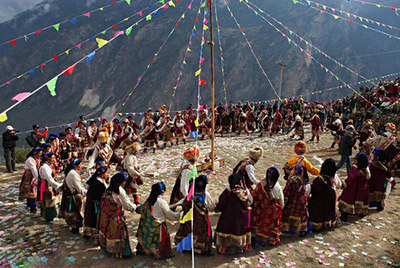
The Guozhuang dance in Tibetan areas has its own characteristics due to different regions. Guozhuang dance tunes are low and elegant, vigorous and heroic, condensed and deep, dragging many and long, like the ups and downs of huge waves. The dance is free and easy, bold and steady, like an eagle spreading its wings. Light and lively and bold. When dancing, the participating dancers all bend over and put on their shoulders. The dance starts smoothly and slowly. When it is near the end, the movements are small and rapid, and the changes are fast. The singing and dancing all end in a happy and warm atmosphere. However, some Guozhuang dances have a strict sequence from beginning to end. The general procedures are: Yiwa (Guozhuang preface song), Yangzhuo (Zhaofu Guozhuang), Si Zhuo (Yingbin Guozhuang), Dui Zhuo (praising Guozhuang) Zong Zhuo (meeting Guozhuang), Zhuo or Zhang Zhuo (saying goodbye to Guozhuang), Guzhuo (retaining Guozhuang) and Tashi Ju (ending song of Guozhuang). In addition to the preface and tail songs. Each program has several tunes or dozens of tunes, but the singing must be performed according to the program, and the next program will be performed after the program is completed.
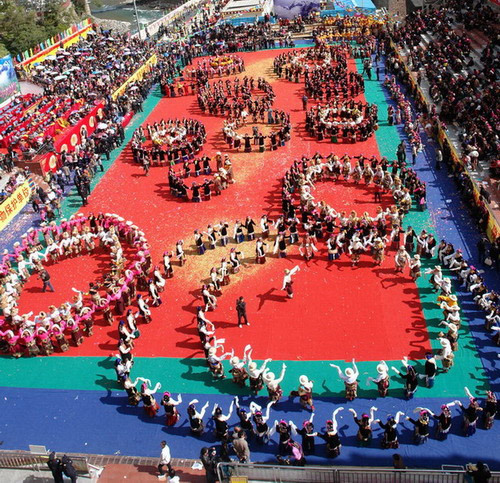
2. Significance of inheritance
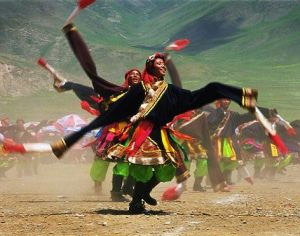
Tibetan Guozhuang contains rich Tibetan cultural connotations, complete and diverse forms, distinctive regional characteristics, strong national style, and a deep mass foundation. It contains traditional humanistic spirits such as friendship and unity, and has high artistic and social value.
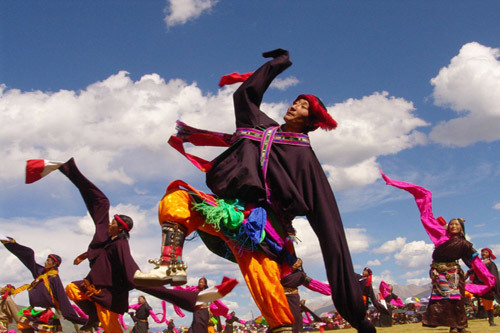
下一条
下一条
最新动态
2022-08-23
The current outbreak, the responsibility is on the shoulder, Balagzon in action!
Since the outbreak of the epidemic in Tibet on August 7, 2022, a large number of tourists from Tibet to Yunnan have entered Shangri-La from National Highway 214. The People's Government of Diqing Prefecture has issued a series of relevant policies and measures and actively responded. Medical staff, police and other front-line personnel stick to the front line, have been involved in the "war of resistance" of the epidemic without gunpowder smoke, and jointly participate in dealing with a major public health security incident faced by mankind.



